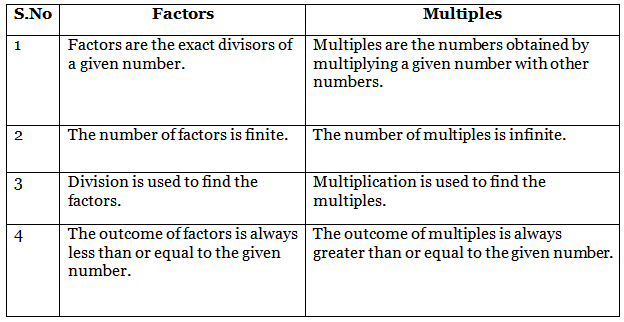Factors and Multiples | The Complete SAT Course - Class 10 PDF Download
| Table of contents |

|
| What are Factors? |

|
| Definition of Multiples |

|
| Difference Between Factors and Multiples |

|
| Factors and Multiples Examples |

|
| Frequently Asked Questions (FAQs) on Factors and Multiples |

|
What are Factors?
Factors are numbers that divide another number exactly without leaving a remainder. For example, if we consider the number 24, its factors are 1, 2, 3, 4, 6, 8, 12, and 24. All these numbers can divide 24 exactly without leaving any remainder.
- Prime Numbers: If a natural number has only two factors, i.e. 1 and the number itself, it is called a prime number. For example, the number 2 is a prime number as it has only two factors, i.e. 1 and 2.
- Relationship between Factors and Multiples: Factors and multiples are related to each other. If a number is a factor of another number, it is also a multiple of that number. For example, 4 is a factor of 24, so 24 is a multiple of 4. Similarly, 6 is also a factor of 24, so 24 is a multiple of 6.

Definition of Multiples
Multiples of a number are obtained by multiplying that number with other natural numbers. For example, the multiples of 2 are 2, 4, 6, 8, 10, 12, 14, 16, 18, 20, and so on. Multiples of 3 are 3, 6, 9, 12, 15, 18, 21, and so on. Similarly, multiples of 5 are 5, 10, 15, 20, 25, and so on.
- Relationship between Multiples and Factors: If a number is divisible by another number, then the second number is a factor of the first number. For example, 12 is divisible by 3 and 4. Hence, 3 and 4 are factors of 12. Similarly, if a number is a multiple of another number, then the second number is a divisor of the first number. For example, 12 is a multiple of both 3 and 4.
- Common Factors and Multiples: Every number has 1 and itself as its factors. Therefore, every number is a multiple of 1 and itself. Also, the number 1 is a common factor of every integer, and every integer is a multiple of 1.
Difference Between Factors and Multiples
The difference between factors and multiples are given here in tabular form. Go through the below table to understand the difference between them.

Factors and Multiples Examples
Examples of Factors:
(i) Factors of 12:
The factors of 12 are the numbers that divide 12 exactly without leaving a remainder. These numbers are 1, 2, 3, 4, 6, and 12. For example, 2 is a factor of 12 because 2 divides 12 exactly leaving no remainder, whereas 5 is not a factor of 12 because 5 does not divide 12 exactly.
(ii) Factors of 20:
The factors of 20 are the numbers that divide 20 exactly without leaving a remainder. These numbers are 1, 2, 4, 5, 10, and 20. For example, 4 is a factor of 20 because 4 divides 20 exactly leaving no remainder, whereas 7 is not a factor of 20 because 7 does not divide 20 exactly.
Examples of Multiples:
(i) Multiples of 4:
Multiples of 4 are the numbers obtained by multiplying 4 with other natural numbers. These numbers are 4, 8, 12, 16, 20, and so on. For example, 12 is a multiple of 4 because 4 multiplied by 3 gives 12, whereas 9 is not a multiple of 4 because it cannot be obtained by multiplying 4 with a natural number.
(ii) Multiples of 7:
Multiples of 7 are the numbers obtained by multiplying 7 with other natural numbers. These numbers are 7, 14, 21, 28, 35, and so on. For example, 21 is a multiple of 7 because 7 multiplied by 3 gives 21, whereas 18 is not a multiple of 7 because it cannot be obtained by multiplying 7 with a natural number.
Frequently Asked Questions (FAQs) on Factors and Multiples
What is the difference between factors and multiples?
Factors of a number are the numbers that divide that number exactly without leaving a remainder, while multiples of a number are obtained by multiplying that number with other natural numbers. For example, the factors of 12 are 1, 2, 3, 4, 6, and 12, while the multiples of 4 are 4, 8, 12, 16, and so on.
What is a prime number?
A prime number is a natural number that has only two factors, 1 and the number itself. For example, the number 2 is a prime number because it has only two factors, 1 and 2.
What is the relationship between factors and multiples?
If a number is a factor of another number, it is also a multiple of that number. For example, 4 is a factor of 24, so 24 is a multiple of 4.
How do you find the factors of a number?
To find the factors of a number, you need to list all the numbers that divide that number exactly without leaving a remainder. For example, the factors of 20 are 1, 2, 4, 5, 10, and 20.
What is a common factor?
A common factor is a factor that is shared by two or more numbers. For example, the common factors of 12 and 18 are 1, 2, 3, and 6, because these numbers can divide both 12 and 18 exactly without leaving a remainder.
|
433 videos|220 docs|166 tests
|















